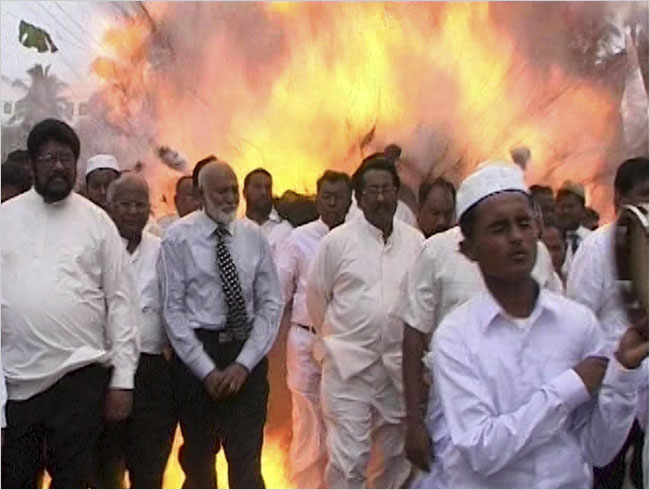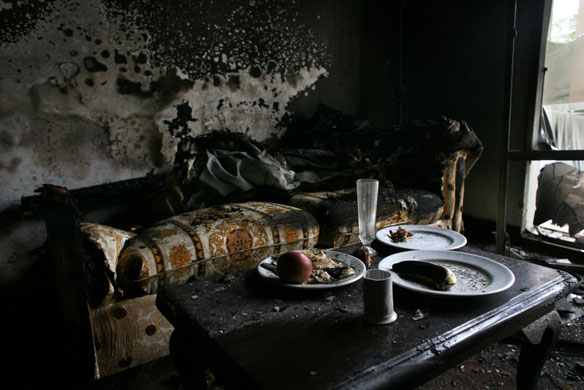Representation in any public art today has to include using old forms to capture what is distinctive about our time. Eventually new forms emerge, and we should ask what might become the artistic conventions of a “catastophile” society in which disaster and violence are fatal attractions and spectacular sources of energy. One image that might be on the cusp of old and new is this screen shot of a bombing in Sri Lanka:
This image is distinctive in that the television camera is recording the instant that a bomb exploded at a Muslim festival in Akuressa, killing 15 people. Whereas almost all bombing photographs are of the aftermath, here you can see the blast pattern blossoming in a single, beautiful, terrible, moment of real time. For once, the blast is there to be seen–and sovereign, fully realized in itself without any rationale or judgment. If my account is sounding like a Facist aesthetic glorifying violence, that is indeed one lineage that applies, but not the only one.
The photo is not a pure aesthetic of violence precisely because of the tension between the sheer, annihilating force of the blast and the people about to be enveloped by the shock wave radiating toward them. The fire is already roaring down the street toward the backs of their legs, someone’s destruction already evident from the shirt blown into the air in the upper left. Yet there they are, ordinary people dressed in nicely pressed shirts standing as if posed for a group portrait–Say Cheese!–and completely oblivious to the blast. What is in fact one event seems to be two very different events joined together by special effects. The photograph actually captures another distortion: what should be two separate things–the violence of war and a civic festival–are actually smashed together. Spectacular violence usurps the civic spectacle.
The photo from Sri Lanka captures something important because of its stunned suspension of temporal movement. The moment of stopped time–which is part of every photograph–here reveals the moral chasm between violence and civic life. That is not the only way to capture the reality of civil war, however.
This photograph of a burnt hotel room was taken at the Marriott Hotel in Islamabad. The blast last September killed at least 60 people and injured more than 260. This image could be the opposite of the one above. Instead of the moment of immolation, we see the slow aftermath of loss; instead of people about to be harmed, we see a room abandoned to emptiness; instead of fire, cinders.
What most strikes me is how the picture works as a still life. The plates, glass, cup, and food could have been done by an Old Master. The play of light and shadow, and of sheen and substance, creates that timeless depiction of inevitable decomposition that was the subject of the genre. And so this tableau could be anywhere in the world, a small monument to gracious living that was instead lost to destruction. Seemingly timeless, but perhaps all too representative of our time.
Photographs by Reuters TV and Pedro UgarteAFP-Getty Images. The term “catastrophile” comes from Peter Sloterdijk, Critique of Cynical Reason, trans. Michael Eldred (Minneapolis: University of Minnesota Press, 1987), p. 120.


The video still is remarkable. Talk about putting a human face to the suffering. Here you can clearly see the people about to engulfed by a fireball, completely oblivious, and as a viewer you can do nothing. This is the moment before anyone has time to even shout ‘look out…’
Terrifying.
This post also shows the importance and power of both video and still photography. The top image with it’s remarkable revelation of a moment in time would be near impossible with a still camera, only a single video frame could capture it. The one below reveals the considered reflective power of photography. We photographers choose where to point the camera and when to press the shutter – making the act of photographing a reactive action (for the most part). Video, once rolling, is a much more passive act of recording.
In today’s debate about video vs still, here we can see why we need both.